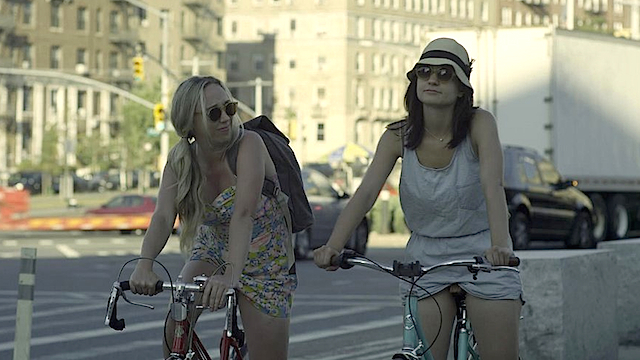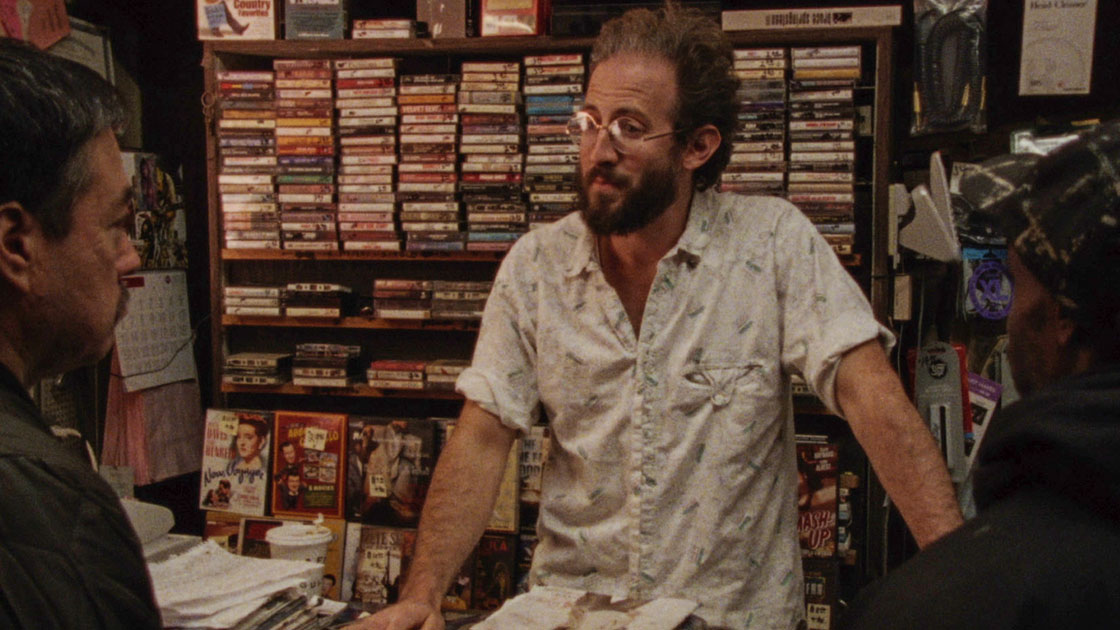By providing your information, you agree to our Terms of Use and our Privacy Policy. We use vendors that may also process your information to help provide our services. This site is protected by reCAPTCHA Enterprise and the Google Privacy Policy and Terms of Service apply.
Why Are So Many Indie Movies Set In Brooklyn?
Steve Dollar

Once was a time, Brooklyn was a bit exotic. When iconic sites (Coney Island, Red Hook, Brighton Beach) showed up in movies, they usually symbolized the borough’s ethnic vigor and a kind of throwback authenticity signifying the “real” New York, as opposed to the churning glass-and-steel Moloch of Manhattan just across the bridges.
The proliferation of microbudget features set in Brooklyn has changed that, much as Brooklyn itself has rapidly changed, conveniently in step with the advance of viral media, cheap digital photography and post-mumblecore masses of young filmmakers hoping to ride a film festival premiere to success. And they would seem to be achieving that goal, if the volume of debuts at Sundance and SXSW set in “hipster Brooklyn” are a valid indication. What hath “Girls” wrought? To paraphrase Alfred Jarry, “After us, the savage latte.”
Of course, to complain that there are too many low-budget movies made by young filmmakers in Brooklyn is like complaining that too many French New Wave movies were made in Paris, or too many Faulkner novels were set in Yoknapatawpha Country. Variety’s Ramin Setoodeh groused about the latest wave of Brooklyn indies sullying Park City, but comedies like “Appropriate Behavior” and “Obvious Child,” which offer personable, original and very funny perspectives from within a larger milieu, aren’t themselves the problem. It’s more the way standard Brooklyn locations have become visual cliches, default backdrops that are employed uncritically in what, collectively, looks like a documentary about gentrification.

While cringing recently through a viewing of “Fort Tilden,” which won the grand jury prize for narrative feature at SXSW, I kept wishing the hapless, bubble-headed-by-design characters, adrift in a Brooklyn of darker skin shadings, might stumble into the Bedford-Stuyvesant bar where Swanson (Tim Heidecker) has a deeply uncomfortable (for the audience) encounter in Rick Alverson’s “The Comedy.” The latter, an often brutal (and brutally funny) dissection of privilege, hipsterism and spiritual malaise, turns its caustic anti-hero’s trans-borough odyssey into sharp social commentary. “Fort Tilden” feints at such, but aside from its climactic arrival at the suitably alien shore of its title – a famously obscure beach in the Rockaways – the “colorful” Brooklyn beyond Bedford and 7th serves only as a prop. To be fair, that’s the movie’s one great scene, when the writing stops trying to be funny.
A similar vista introduces Eliza Hittman’s feature debut “It Felt Like Love,” which might be another of Variety’s accursed Brooklyn indies (it premiered at Sundance last year), except that its primary subject isn’t even legal yet and most of its story unfolds in the workaday neighborhoods of Gravesend, Bensonhurst and Flatbush. Photographed by cinematographer Sean Porter with an exquisite sensitivity to the waterfront palette, the film opens on 14-year-old Lila (Gina Piersanti) at Gerritsen Beach. Seen from the back, wearing a painfully unfashionable one-piece bathing suit, she gingerly steps toward the waves, too timid to take a plunge, before turning to gaze at the camera, the sunscreen on her face approximating mime make-up. Moments later, she joins her more sexually (and socially) advanced best friend Chiara (Giovanna Salimeni) and her boyfriend du jour as they break into a beach house.
The juvenile transgression anticipates more to come, as Lila, a lonely and alienated girl forever in the shadow of the more superficially sophisticated Chiara, begins to obsess and then stalk a local “thug,” the buff-and-gruff Sammy (Ronen Rubenstein) who, at 23, has no interest in this gawky kid. Nonetheless, an air of dread accumulates as the scenario progresses, and Lila’s determination leads her towards danger and humiliation.
Though so much of the story is told in extreme close-up, capturing the way that adolescents regard their own budding, newly adult bodies, Hittman conveys a vivid sense of place without resorting to wide shots. She draws heavily on her own experiences as a teenager in Flatbush, where her parents still live (in the house whose basement is the site of the film’s palpably sketchy party scenes, where raw, underground hip-hop beats accompany weed-and-malt-liquor-saturated sexual exploits).
“I spent a lot of time re-exploring and looking at those neighborhoods again,” said Hittman, whose film opens Friday at IFC Center. “I thought about how you don’t see them on screen.” A student of filmmaker Thom Andersen (whose “Los Angeles Plays Itself” is a classic psycho-geography of Los Angeles on film) at Cal Arts, the director is keenly aware of how Brooklyn does, and doesn’t, play itself. The Gerritsen beach bungalows, many since destroyed by Hurricane Sandy, often have doubled for New England locations, she noted. Her family’s neighborhood has substituted for “suburban Westcherster-y Connecticut.” Meanwhile, the film’s grittier precincts are the kind of spots more likely familiar from episodes of “Law and Order.” Here, they stand for themselves.
“Location is established through the people,” Hittman said. “I think people’s perception of the city is so narrow. People used to move here in the 1960s, ‘70s and ‘80s because they had radical ideas about sex and art and politics. Now people have radical ideas about the image of what their lives look like. I’m not being critical, I just think it’s different than what people used to move here for. There’s a closed-off-ness. Maybe the film opens people up to considering other areas. Brooklyn is a vast borough.”

“It Felt Like Love” isn’t an isolated outlier among recent Brooklyn indies. Dustin Guy Defa’s superb, 18-minute short “Person to Person,” next showing at New Directors/New Films, is situated in Park Slope, but nonetheless uncovers a motherlode of old school Brooklyn character in the dusty grooves of a ragtag Fifth Avenue used vinyl shop that abides, against all odds, amid the boutiques and brigades of baby-strollers. To hear the word “coffee” pronounced “cwaffee” in perfect Flatbushian is to know that the soul of Brooklyn never dies. Likewise immersed in its location is Andrew Dosunmu’s “Mother of George,” another 2013 Sundance discovery, that steeped audiences in the Nigerian community of Crown Heights – a cultural backdrop more distant from Lena Dunham’s Bushwick than the 10 buck car service ride that separates them geographically.
“Soft in the Head,” the latest feature from indie actor-writer-director Nathan Silver, also is embedded in the neighborhood. His apartment there is the setting for the film’s makeshift homeless shelter, a volatile community detailed with frazzled-nerve verite. The story’s catalyst is batshit-crazy Natalia (Sheila Exteberria), an out-of-control fuse to an unknowing powderkeg, who brings chaos to the life of the shelter’s kindly benefactor Maury (Ed Ryan) when she gets kicked out of her apartment.
“New York is anxiety,” said Silver, who favors a process of improvising stories with actors (and non-actors, including his own family members). “I think that’s why I stayed here, because I’m an anxious individual and I want to be somewhere that is anxiety-inducing. It’s a suffocating experience living here and making work here but whenever I go anywhere else it feels like I haven’t taken medication or something.” The film, which opens April 18 at Cinema Village, suggests a rejoinder to hipster resume projects, although it hasn’t received much play at film festivals that embrace the same.
“I feel uncomfortable in a bad way in Williamsburg and the East Village now,” said Silver, who also shot in Bedford-Stuyvesant and Queens. “Whereas here I feel uncomfortable in the best possible way. I want to capture that, even though I don’t share the same background as the folks who live here.”
Of course, the notion of “the folks who live here” is constantly in flux. And Silver knows he’s part of that, too. As more filmmakers venture further into the borough, will their films look more deeply at the culture around them or only reflect a longer subway ride to hipsterland? Hittman feels lucky to have had a different experience. “Whenever I get on the Q train and ride south towards Coney, I always feel more at home than through other parts of Brooklyn, than walking around areas that have radically transformed,” she said. “That’s where my memories are of the city now. You have to use what’s interesting in your life and mine your own experiences. Mine just happen to be in these areas that are untouched by gentrification.”
By providing your information, you agree to our Terms of Use and our Privacy Policy. We use vendors that may also process your information to help provide our services. This site is protected by reCAPTCHA Enterprise and the Google Privacy Policy and Terms of Service apply.
















